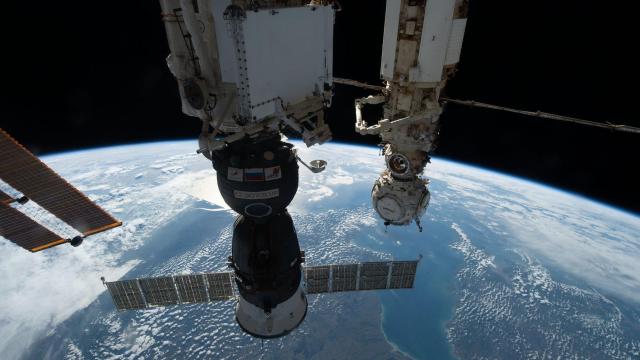An inspection has revealed an 0.8-millimetre-wide hole in the Soyuz MS-22 spacecraft that sprung a coolant leak outside the International Space Station last week. Russian space agency Roscosmos will make a decision on the flight-worthiness of the spacecraft later this month, at which time Russia may choose to expedite the launch of a replacement capsule.
The hole is located on the ship’s instrumentation compartment on the Soyuz service module, according to Roscosmos chief Yury Borisov and as reported by state-run TASS news agency. “The primary guidance, navigation, control and computer systems of the Soyuz are in the instrumentation compartment, which is a sealed container filled with circulating nitrogen gas to cool the avionics equipment,” NASA says.
The Soyuz MS-22 sprung a leak on December 15, sending streams of coolant into space and cancelling a Russian spacewalk. NASA and Roscosmos have both stated that the incident poses no risk to the crew or the orbiting space station. A preliminary inspection with a robotic arm confirmed the leak shortly after it began on Thursday, with a follow-up inspection, performed earlier today, now confirming the hole, which may have been caused by a micrometeorite or a tiny piece of space junk.
Today’s inspection “revealed that there is a tiny hole” in the instrumentation compartment “measuring about 0.8mm, which caused the leak,” Borisov said Monday, describing the ongoing situation as “not very pleasant.” The Russian space agency has set a deadline of December 27 to determine the status and fate of the damaged Soyuz spacecraft. Two working groups will decide whether the spacecraft can host passengers and return to the surface or if it needs to be junked.
The MS-22 capsule is slated to return NASA astronaut Frank Rubio and Roscosmos cosmonauts Sergey Prokopyev and Dmitri Petelin to Earth in early spring, but the trio may have lost their ride. A SpaceX Crew Dragon is also parked outside the ISS, but that’s reserved for NASA astronauts Nicole Mann and Josh Cassada, Koichi Wakata of the Japan Aerospace Exploration Agency (JAXA), and Anna Kikina of Roscosmos. The Crew Dragon cannot accommodate seven people, but the option exists for the Russian space agency to expedite its next Soyuz launch to the ISS, the MS-23 mission.
“Of course, we have backup options,” Borisov told the state-run Izvestia media outlet. “We will prepare the spaceship faster. Instead of the scheduled March descent, we will prepare it somewhere by February 19. It is already installed at the Baikonur spaceport and undergoing all the tests,” he said. To which he added: “In this situation, we will simply undock the Soyuz MS-22, it will descend to Earth and we will send a second [uncrewed] spaceship to bring back the crew.”
2. The decision on the future actions will be made on December 27.
3. If there will be any doubts in the safety of Soyuz-MS22, it will be replaced with Soyuz MS-23 which can be prepared for flight by February 19.— Katya Pavlushchenko (@katlinegrey) December 19, 2022
It’s not yet clear if the MS-22 is toast, but there is some cause for concern. As the Associated Press reports, the temperature inside the capsule’s crew section rose to 86 degrees Fahrenheit (30 degrees Celsius) as a result of the leak, while the temperature in the equipment section temporarily rose to 104 degrees Fahrenheit (40 degrees Celsius) prior to ground teams shutting down some of the spacecraft’s systems.
The crew used fans to blow cooler air into the Soyuz capsule in an attempt to lower the cabin’s temperature, Roscosmos said, adding that the “increase in temperature on the Soyuz MS-22 spacecraft is admissible and isn’t critical for the functioning of the equipment or health of the crew in case they need to be in the spacecraft.” Borisov rejected speculation that the Soyuz cabin temperature rose to 122 degrees Fahrenheit (50 degrees Celscius), according to TASS.
According to NASA, Roscosmos flight controllers performed a successful test of the Soyuz MS-22’s thrusters on Friday, so there’s at least some positive news. In addition, NASA is moving ahead with a planned spacewalk to continue installation of the International Space Station Roll-Out Solar Array (iROSA), which was supposed to happen today but will instead take place on Wednesday, December 21.
